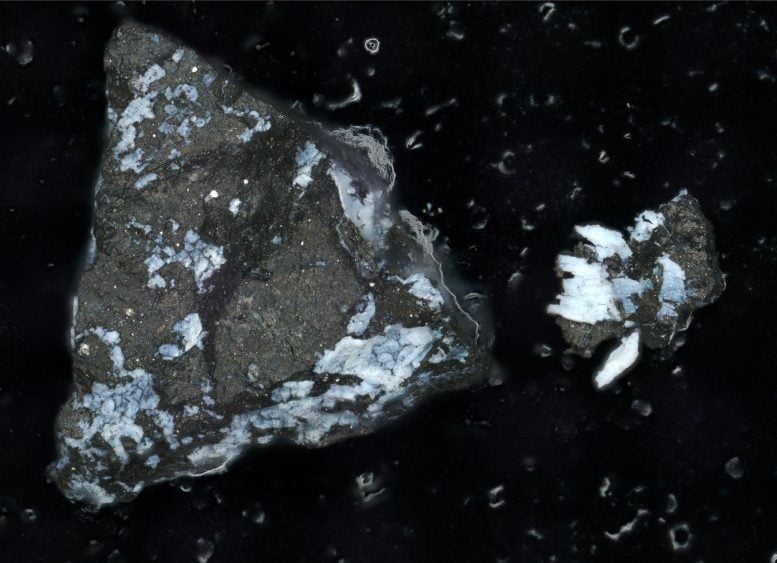
Microscope image of a dark particle from Bennu, about a millimeter long, with a bright phosphate crust. On the right, a smaller fragment has broken off. Credit: De Lauretta & Connolly et al. (2024) Meteoritics & Planetary Science, doi:10.1111/maps.14227
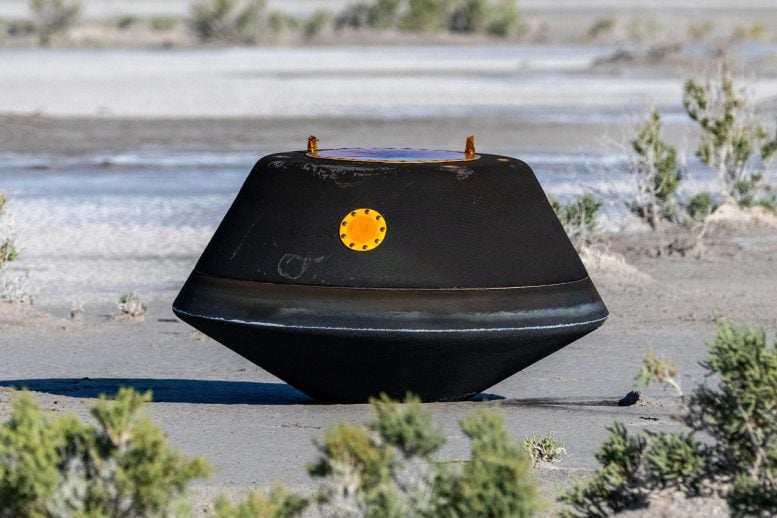
The sample return capsule from NASA’s OSIRIS-REx mission is seen shortly after landing in the desert on September 24, 2023, at the Department of Defense’s Test and Training Center in Utah. The sample was collected from the asteroid Bennu in October 2020 by NASA’s OSIRIS-REx spacecraft. Credit: NASA/Keegan Barber
Bennu Sample Journey and Delivery
Launched on September 8, 2016, the OSIRIS-REx spacecraft, named Origins, Spectral Interpretation, Resource Identification, and Security–Regolith Explorer, began its journey to the near-Earth asteroid Bennu to collect a sample of rocks and dust from its surface. OSIRIS-REx was the first U.S. mission to collect a sample from an asteroid. The spacecraft delivered the sample, weighing 4.3 ounces, or 121.6 grams, to Earth on September 24, 2023.
“It’s incredibly exciting to finally have the opportunity to study the OSIRIS-REx sample of Bennu after all these years,” said Dante Lauretta, OSIRIS-REx principal investigator and professor of planetary sciences at the University of Arizona Lunar and Planetary Laboratory. “This advance not only answers long-standing questions about the early solar system, but also opens new avenues of research into how Earth formed as a habitable planet. The information presented in our review paper has sparked increased curiosity, which has fueled our desire to explore further.”
Lauretta is co-lead author of an article published in Meteorites and planetary sciences This document details the nature of the asteroid sample. It also serves as an introduction to the Bennu Sample Catalog, an online resource where information about the sample is made public and scientists can request samples for their own research.
“The publication of the first paper led by Dr. Lauretta and Dr. Connolly describing the Bennu sample is a major milestone for the mission and for the University of Arizona Lunar and Planetary Laboratory and head of the Department of Planetary Sciences. Our faculty, scientists, and students will continue to study the sample for years and decades to come. For now, we can only imagine the stories of our planet’s origins and the life that still exists to be told from the Bennu grains already in our labs.”
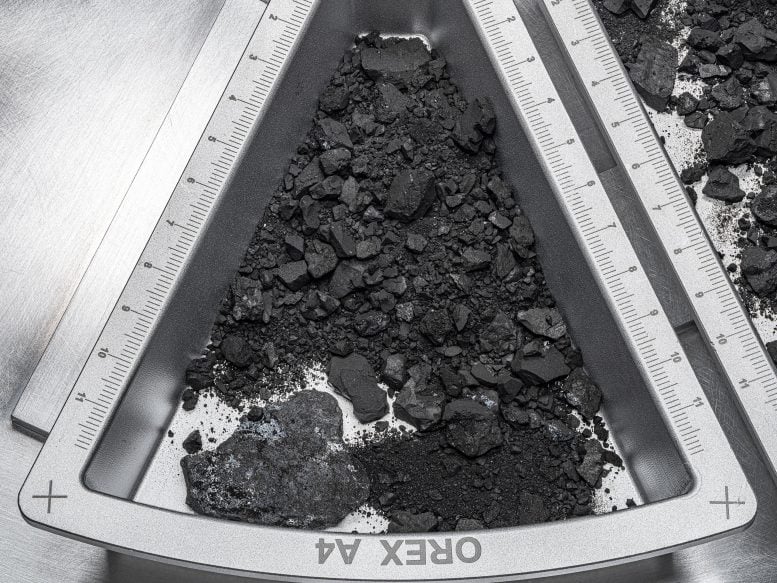
Top view of one of the containers holding rocks and dust from the asteroid Bennu, with a measurement scale in centimeters. Credit: NASA/Erika Blumenfeld and Joseph Aebersold
An “aquatic past” for Bennu?
Analysis of the Bennu sample revealed interesting information about the asteroid’s composition. Dominated by clay minerals, including serpentine, the sample reflects the type of rock found on Earth’s mid-ocean ridges, where materials from the mantle, the layer beneath the Earth’s crust, meet water.
This interaction between seawater and materials in Earth’s mantle results in the formation of clay and gives rise to a variety of minerals, including carbonates, iron oxides and iron sulfides. But the most unexpected discovery in the Bennu sample is the presence of water-soluble phosphates, Lauretta said. These compounds are biochemical components of all known life on Earth today.
A similar phosphate was found in the sample from the asteroid Ryugu delivered by the Japan Aerospace Exploration Agency’s Hayabusa2 mission in 2020. But the sodium magnesium phosphate detected in the Bennu sample is distinguished by the absence of inclusions, which are like small bubbles of other minerals trapped in the rock, and by the size of its grains, unprecedented in a meteorite sample, Lauretta said.
The discovery of magnesium and sodium phosphates in the Bennu sample raises questions about the geochemical processes that brought these elements together and provides valuable clues about Bennu’s historical conditions.
“The presence and state of phosphates, along with other elements and compounds on Bennu, suggest a watery past for the asteroid,” Lauretta said. “Bennu could once have been part of a wetter world. However, this hypothesis requires further investigation.”
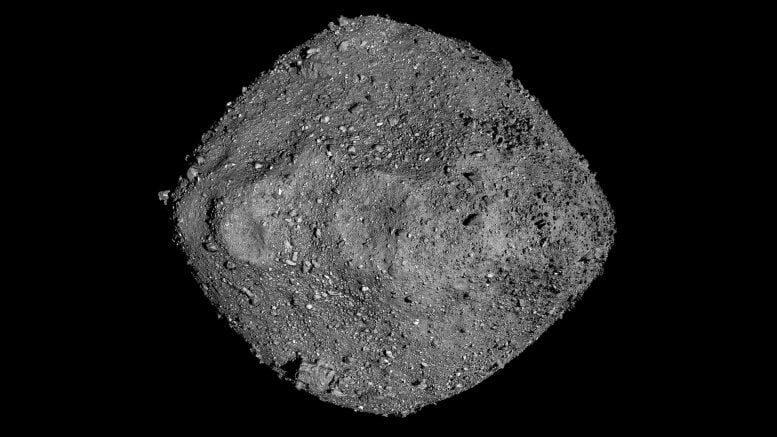
This mosaic of Bennu was created from observations made by NASA’s OSIRIS-REx spacecraft, which hovered near the asteroid for more than two years. Credit: NASA/Goddard/University of Arizona
From a young solar system
Despite its possible history of interaction with water, Bennu remains a chemically primitive asteroid, with elemental proportions closely resembling those of the Sun.
“The sample we recovered is the largest reservoir of unaltered asteroid material on Earth today,” Lauretta said.
The composition of the asteroid offers a glimpse into the beginnings of our solar system, more than 4.5 billion years ago. The rocks have retained their original state, having neither melted nor solidified since their creation, confirming their primitive nature and ancient origins.
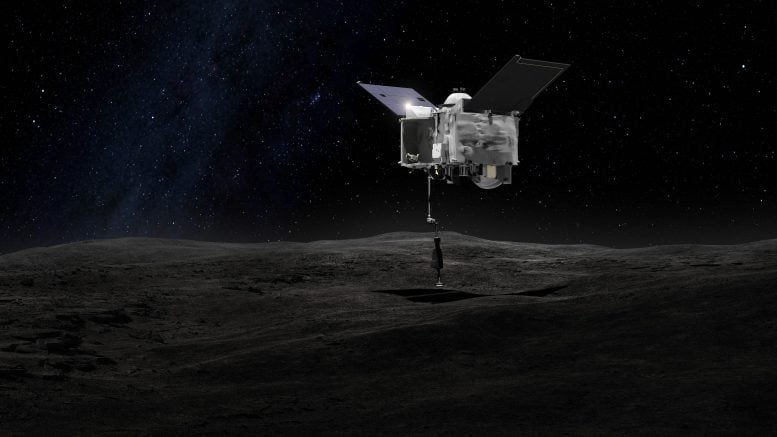
This artist’s impression shows the Origins Spectral Interpretation Resource Identification Security – Regolith Explorer (OSIRIS-REx) spacecraft making contact with the asteroid Bennu using the Touch-And-Go Sampling Arm Mechanism, or TAGSAM. The mission successfully returned a sample of Bennu’s surface coating to Earth for study. Credit: NASA
Some clues about the building blocks of life
The team also confirmed that the asteroid was rich in carbon and nitrogen. These elements are key to understanding the environments where Bennu’s materials came from and the chemical processes that transformed simple elements into complex molecules, potentially laying the foundation for life on Earth.
“These results underscore the importance of collecting and studying materials from asteroids like Bennu – especially low-density materials that would normally burn up upon entering Earth’s atmosphere,” Lauretta said. “These materials are key to understanding the complex processes of solar system formation and the prebiotic chemistry that may have contributed to the emergence of life on Earth.”
And after
Dozens of other laboratories in the United States and around the world will receive portions of the Bennu sample from NASA’s Johnson Space Center in Houston in the coming months, and many more scientific papers describing the Bennu sample are expected in the coming years from the OSIRIS-REx sample analysis team.
“The Bennu samples are extraterrestrial rocks of fascinating beauty,” said study co-lead author Harold Connolly, a mission scientist who leads the sample analysis team, a professor at Rowan University in Glassboro, New Jersey, and a visiting scientist at the University of Arizona. “Every week, the OSIRIS-REx sample analysis team’s analyses provide new and sometimes surprising results that help establish important constraints on the origin and evolution of Earth-like planets.”
Reference: “Asteroid (101955) Bennu in the Laboratory: Properties of the Sample Collected by OSIRIS-REx” by Dante S. Lauretta, Harold C. Connolly, Joseph E. Aebersold, Conel M. O’D. Alexander, Ronald-L. Ballouz, Jessica J. Barnes, Helena C. Bates, Carina A. Bennett, Laurinne Blanche, Erika H. Blumenfeld, Simon J. Clemett, George D. Cody, Daniella N. Della Giustina, Jason P. Dworkin, Scott A. Eckley, Dionysis I. Foustoukos, Ian A. Franchi, Daniel P. Glavin, Richard C. Greenwood, Pierre Haenecour, Victoria E. Hamilton, Dolores H. Hill, Takahiro Hiroi, Kana Ishimaru, Fred Jourdan, Hannah H. Kaplan, Lindsay P. Keller, Ashley J. King, Piers Koefoed, Melissa K. Kontogiannis, Loan Le, Robert J. Macke, Timothy J. McCoy, Ralph E. Milliken, Jens Najorka, Ann N. Nguyen, Maurizio Pajola, Anjani T. Polit, Kevin Righter, Heather L. Roper, Sara S. Russell, Andrew J. Ryan, Scott A. Sandford, Paul F. Schofield, Cody D. Schultz, Laura B. Seifert, Shogo Tachibana, Kathie L. Thomas-Keprta, Michelle S. Thompson, Valerie Tu, Filippo Tusberti, Kun Wang, Thomas J. Zega, CWV Wolner and , June 26, 2024, Meteorites and planetary sciences.
DOI: 10.1111/maps.14227